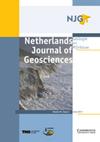A non-marine horseshoe crab from the Middle Triassic (Anisian) of the Netherlands
IF 2.3
2区 地球科学
Q3 GEOSCIENCES, MULTIDISCIPLINARY
Netherlands Journal of Geosciences-Geologie En Mijnbouw
Pub Date : 2023-01-10
DOI:10.1017/njg.2022.16
引用次数: 0
Abstract
Abstract Horseshoe crabs (Xiphosura) have a long evolutionary history starting in the Ordovician, but they have rarely been reported from the Netherlands. We report on the first Triassic horseshoe crab from the Netherlands identifiable to the species level, a specimen of the limulid Limulitella bronnii. We provide the first diagnosis for this species and refigure the holotype. The new specimen was found in the Middle Triassic (Anisian) Muschelkalk sediments of the Vossenveld Formation, in the Illyrian part of the stratigraphic profile of the Winterswijk quarry complex. The Winterswijk specimen represents the youngest occurrence of L. bronnii. The inferred non-marine habitat of this horseshoe crab species elsewhere in conjunction with occurrences of plant and insect remains within the same layer at Winterswijk suggest the specimen herein most probably did not live in marine conditions either. This species has previously been found in non-marine sediments in France and Germany, expanding its geographic range northward. Several faunal elements from Winterswijk including L. bronnii show resemblance to the roughly co-eval non-marine components of the Anisian Grès à Voltzia Formation in NE France, suggesting a paleobiogeographic connection between these regions in Western Europe.产于荷兰中三叠世(安尼西亚)的一种非海生马蹄蟹
马蹄蟹(Xiphosura)自奥陶纪起就有悠久的进化史,但在荷兰的报道却很少。我们报告了荷兰三叠纪马蹄蟹的第一种可识别的物种水平,limulid Limulitella bronnii标本。我们为这个物种提供了第一个诊断,并重新绘制了全型。这个新标本是在Winterswijk采石场地层剖面的伊利里亚部分,在Vossenveld组的中三叠世(anisiian) Muschelkalk沉积物中发现的。Winterswijk标本代表了最年轻的L. bronnii。推断出这种马蹄蟹在其他地方的非海洋栖息地,以及在Winterswijk同一层内出现的植物和昆虫遗骸,表明这里的标本很可能也没有生活在海洋环境中。这个物种以前在法国和德国的非海洋沉积物中被发现,扩大了其地理范围向北。包括L. bronnii在内的Winterswijk的一些动物成分与法国东北部的Anisian gr - Voltzia组的大致共同评估的非海洋成分相似,表明这些地区在西欧之间存在古生物地理联系。
本文章由计算机程序翻译,如有差异,请以英文原文为准。
求助全文
约1分钟内获得全文
求助全文
来源期刊
CiteScore
4.00
自引率
25.90%
发文量
14
审稿时长
>12 weeks
期刊介绍:
Netherlands Journal of Geosciences - Geologie en Mijnbouw is a fully open access journal which publishes papers on all aspects of geoscience, providing they are of international interest and quality. As the official publication of the ''Netherlands Journal of Geosciences'' Foundation the journal publishes new and significant research in geosciences with a regional focus on the Netherlands, the North Sea region and relevant adjacent areas. A wide range of topics within the geosciences are covered in the journal, including "geology, physical geography, geophyics, (geo-)archeology, paleontology, hydro(geo)logy, hydrocarbon exploration, modelling and visualisation."
The journal is a continuation of Geologie and Mijnbouw (published by the Royal Geological and Mining Society of the Netherlands, KNGMG) and Mededelingen Nederlands Instituut voor Toegepaste Geowetenschappen (published by TNO Geological Survey of the Netherlands). The journal is published in full colour.

 求助内容:
求助内容: 应助结果提醒方式:
应助结果提醒方式:


